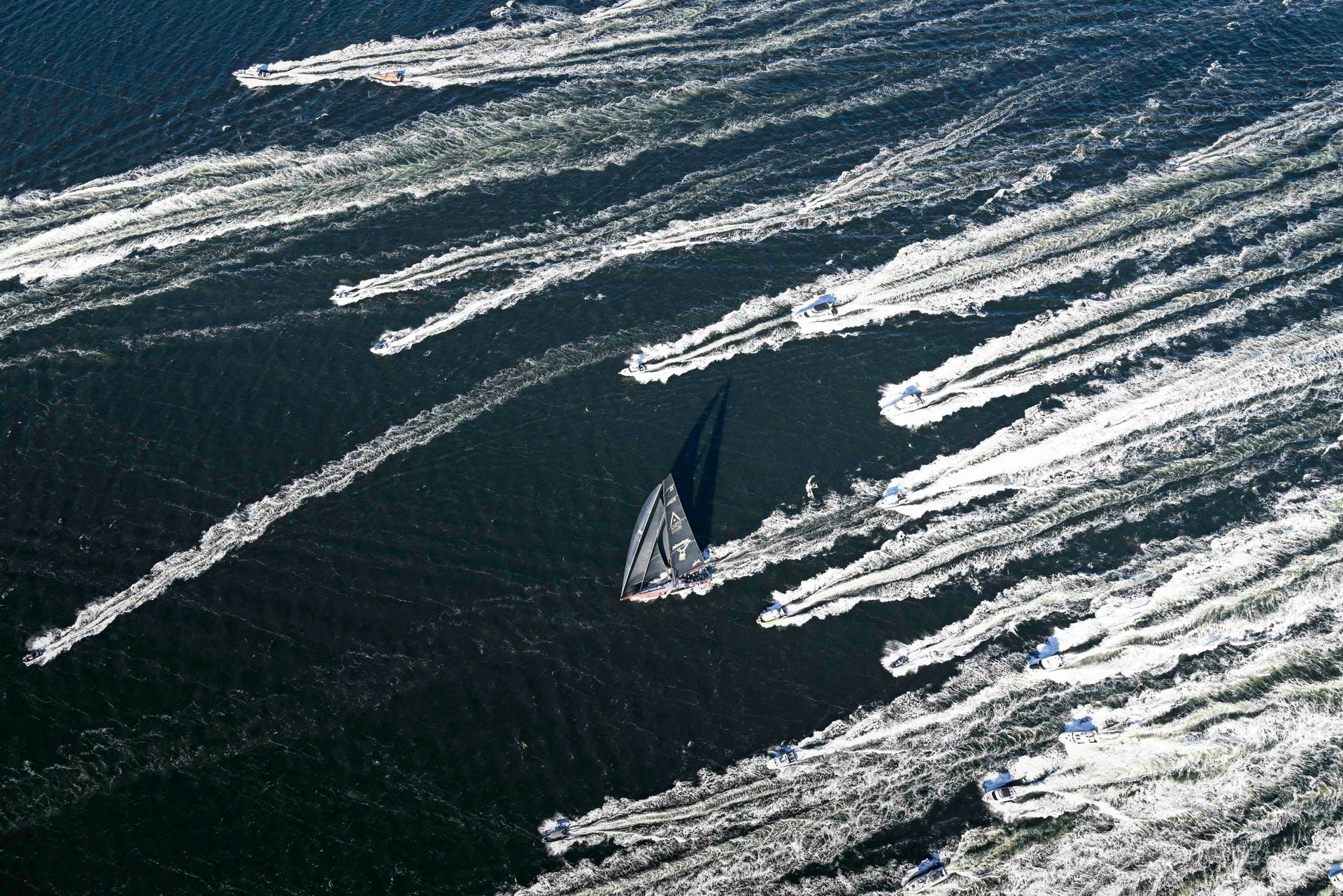SPEED READING: ETCHELLS MAST LEVER
SPEED READING: ETCHELLS MAST LEVER
Tips From Expert Andrew “Dog” Palfrey
The Etchells is one of the most competitive and prestigious one-design classes in the World. Sailors have been challenged to find the boat’s extra speed for over fifty years. We had a chance to interview two-time Etchells World Champion Andrew “Dog” Palfrey, the developer of the popular Mast Lever System.
Dog, thank you for all your great contributions to the Etchells class. Compared to a few years ago, the boat sure seems easier and more fun to sail. Being able to make some very simple, but substantial adjustments easily makes the boat easier to sail fast across the wind range.
Many thanks for the nice comments and also for the opportunity to help spread the good word to our fellow Etchells sailors. It is gratifying for me to go to Etchells events and see almost universal take-up of the Lever system. As you mention, it does make life easier for the teams to extract best performance from the aero package.
Focusing specifically on the use of the mast lever, in simple terms: What is the correct move with the lever and the mast at the deck as you go from light to moderate breeze to stronger breeze during a race?
Along with the sheets, the traveller and backstay, the mast lever control is a primary control in helping to get the best from the mast and sails.
The most challenging thing about the Etchells mast and rigging geometry, is that we lack direct control of the headstay (via runners). Also, we can only declare one mainsail and two jibs for the big events, so the ability to power-up and de-power both sails is fundamental to extracting the best performance from an Etchells across the wind-ranges and sea-states we sail in.
I primarily consider the lever system to be a tool that either stiffens or softens the bottom two-thirds of the mast. In basic terms, we want to stiffen the mast in heavy airs and soften in lighter airs. So, to answer your question, on a day where the breeze is strengthening, we would progressively move the mast (via the lever) aft at the deck – thus stiffening the lower two-thirds of the rig.
We need to remember that the effectiveness of the lever is limited by the position of the mast, relative to the mast partner hole (in the fore-aft plane). Headstay length and mast-step position are the variables here.
“In an ideal world, we are always going upwind with the mast all the way back in the partners hole. Why? This gives us the ability for the mast tip be as far forward as possible on the downwind leg. We know this to be fast in all but very windy conditions.”
If we are sailing upwind before the start, and the perfect position sees a gap between the trailing edge of the mast and the back of the mast partners hole, I will consider going aft on the step or lengthening the headstay to close that gap. However, if the forecast is for the wind to increase, I will make sure there is a gap there. This way we have the ability to effectively stiffen the mast by pushing the mast back with the lever. So, having the step a little further forward and/or the headstay length a little shorter than perfect is good insurance in a building breeze.
© Onne Van der Wal
As you either move the lever back or let it forward, what changes are happening to the headstay sag and lower mast bend?
Really good question. In basic terms, moving the lever alters where the maximum bend is allowed to happen vertically in the mast, with the application of backstay and/or mainsheet load.
Simply put, if the lever is pushing the mast aft at the deck, the bend will occur higher up the mast (and vice versa).The effect of a stiffer lower section of the mast also sees the headstay become firmer with the application of backstay and/or mainsheet.
When looking for power, we are generally looking to induce headstay sag. So we allow the mast to bend below the hounds (this also helps the mainsail shape in light airs). The lever will either be pulling the rig forward at the deck (creating pre-bend), or in a neutral position. The mainsail is designed so that minimal backstay is required in lighter winds. Sometimes we are looking to sag the headstay more without changing the mainsail shape at all. This is possible with subtle changes of the lever, backstay and mainsail changes together.
When it is windy and we are looking to de-power, we are generally looking for a firm headstay. This generally means stiffening the mast below the hounds, so the effect of backstay and mainsheet more directly tightens the headstay.
“When I look around the fleet when I’m sailing or coaching, the biggest variances I see are in headstay sag. When I am sailing, I find the hardest thing to set up accurately is the headstay sag. This is because it is not easy to see and replicate and there is no way to accurately reference the sag directly with a mark. But it is one of the key drivers in extracting best performance out of an Etchells.”
I look closely at the entry angle of the jib. If it is very fine, we probably need more sag. Likewise, if it very blunt, I will either ease more jib cunningham or look to remove some headstay sag with the application of mast lever and a little backstay. I also carefully observe the dynamic behavior of the headstay. If it’s windy and wavy and the headstay is moving around a lot, I will prioritize firming it up with more aft lever, tighter backstay and mainsheet.
Is there ever a condition where you leave the lever uncleated? Just allowing the mast to float in the partners?
Never. Allowing the mast to move, or “pump” over every wave will be constantly changing the shape of both sails in a subtle, but counter-productive way. However, in light to medium winds, I do like to know where neutral is.
In our tune-up, I will ease both the forward and aft control lines and observe where the mast is happy sitting. That tells me where the step is positioned relative to the gate and helps me make decisions on whether I should think about moving the step or the headstay length. But then I will cleat the lever controls off again.
Regarding the boat hardware: In 2014, when I first set up the lever in an Etchells, there were lines on both the forward and aft controls. But for the past three years I have set up the forward puller with shock-cord, so that is automatic. The advantage of this is that you only have to deal with one control line (the aft puller). I set the shock cord system up with a cleat, so I can disengage it in heavy air (when it is not required). I also disengage it when checking where neutral is. The disadvantage is more weight, as you do need heavy shock-cord to offset any “pumping” and a 6:1 system. But I think the weight is worth it. Being able to adjust the important controls easily (and from the windward rail) is key.
Is there a good rule of thumb that can be used for how much “gap” behind the mast to start with? Say at the dock with light tension (10 the the Loos gauge) on the headstay and the mast floating?
Yes. As I mentioned above, one of the hardest things to accurately quantify is headstay sag. So any tools that help me replicate fast settings are valuable. The “gap” you mention is one of those tools.
On my personal tuning guide, I have the shroud calibration numbers to suit the North Sails tuning guide tensions. But I also have a column for the “gap”. It’s really important, as it is a key indicator of exactly how the mast will behave in the fore-aft plane when sailing upwind and down.
When on the dock, I will set the backstay up so it pulls the headstay firm. Making sure the lever controls are uncleated, I then apply more backstay and watch the mast at the partners. When it moves forward slightly (the mast starts to bend), I stop pulling the backstay and then ease a small amount so that the mast moves back to its neutral position. This is approximately 10 on the Loos Gauge, but I find this method is better than measuring the headstay with the Loos Gauge (as they are inherently unreliable at low loads).
I then look at (and measure) the gap. I also check shroud tension and headstay length at this time.
- In light airs, I am looking for no gap at all – even to the point where the mast is hard against the aft edge of the mast gate and bending around it by a factor of 5 or so mm.
- In heavy airs I like the gap to be around 20mm, or 3/4’s of an inch.
The gap is controlled by both the step position and headstay length. Personally, I adjust both step and headstay. But there are many ways to skin the same cat. John Bertrand rarely changes his headstay length and does more adjustment on the step.
I would say the most important thing is to develop your own boat’s tuning guide. When racing, make sure you know where you are relative to that. So, if conditions change, or you are lacking speed or height (or have too much – or not enough power), you are best armed to make high percentage decisions on what to change.
“Keep in mind that the sails are a living organism. As they age, they do grow a little. This generally means they become a little deeper and a little rounder in the aft sections. This may not be a negative thing in lighter winds and a bumpy sea. When you add a new sail to the boat, be prepared to exercise some flexibility to your setup to achieve the same effect.”
We are engaged in a wonderful game that is both complex and yet quite simple at the same time. Our sport rewards experience, so don’t be afraid of trying things. But try to keep a record of what works and what doesn’t. Above all, don’t stop asking questions!















